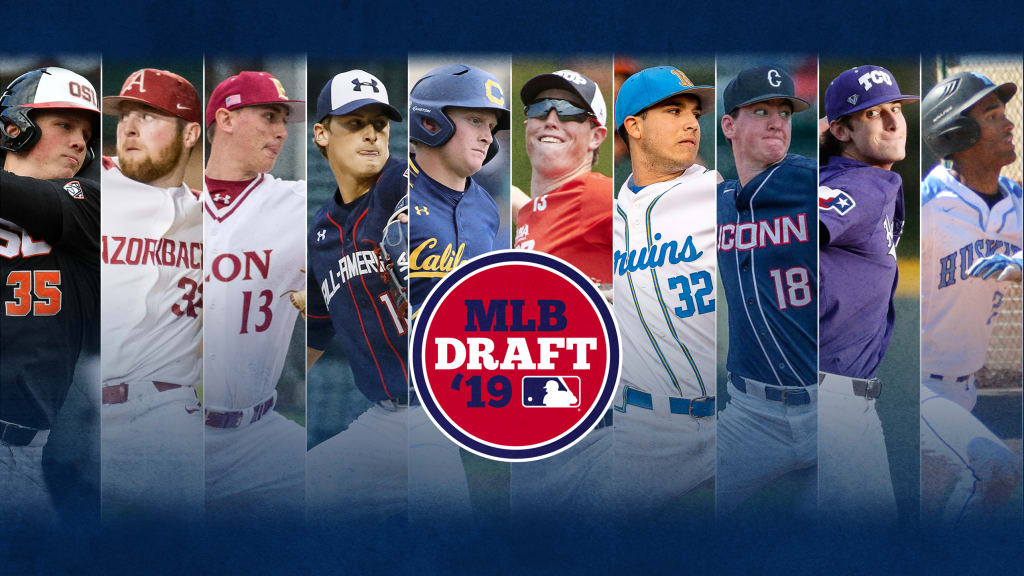
One of the things that’s often pointed out when discussing the differences between Major League Baseball’s Draft and the drafts of other sports is that there is a lack of instant gratification. Players taken in the 40 rounds that were completed last week won’t be seen immediately at the highest level.
While it’s true that no draftee has made it to the big leagues in the year he was drafted since lefty Brandon Finnegan did it in 2014 with the Royals, it often doesn’t take long. Lefties Carlos Rodon and Jacob Lindgren made it up from that 2014 class before the 2015 Draft rolled along for the White Sox and Yankees. In 2016, a pair of right-handers from the ’15 Draft, Carson Fulmer and Koda Glover, made their debuts for the White Sox and Nationals, as did the Astros’ Alex Bregman, in July 2016, just a year after being selected.
It’s taken players from the 2016 and 2017 Drafts a bit more time to make their debuts. Orioles outfielder Austin Hays was the first player up from the Class of 2016, getting called up in September 2017, while Padres lefties Joey Lucchesi and Eric Lauer were the next fastest to debut, both in the early stages of the 2018 season. Kyle Wright led the 2017 Draft by helping the Braves bullpen in September of last year, while another San Diego left-hander, Nick Margevicius, came up this March, followed by Angels right-hander Griffin Canning in late April. No one from the 2018 Draft has yet to debut.
It’s pretty clear that when trying to figure out who from this year’s Draft will make it to the Majors first, pitching is the way to go. But we’ve broken it down into four categories to give you some candidates to root for.
College pitchers
Nick Lodolo, LHP, Reds: The No. 8 overall pick in the Draft was the highest-rated pitching prospect in the class and the first one taken. A big reason was the fact that he should be able to take his three pitches that could be plus at their best, along with his above-average command, and buzz through the Minor Leagues.
George Kirby, RHP, Mariners: The Elon University ace went No. 20 overall after leading all of NCAA Division I baseball with a 17.83 K/BB ratio (107/6 K/BB). With a four-pitch mix and plus control, he should be able to handle an aggressive assignment in 2020 and move quickly from there.
Ryan Garcia, RHP, Rangers: While his stuff isn’t as good as fellow former UCLA Friday night starter Griffin Canning, Garcia does have four pitches he knows how to use with excellent command. Add in the fact that UCLA starters seem to have a tendency to throw harder once they enter the pro game, and the Rangers might have gotten a steal with this second-round pick.
Jacob Wallace, RHP, Rockies: College relievers are always popular picks for lists like this and Wallace is one of the better ones. He tied the Huskies’ single-season saves record (16) in 2019 and missed a ton of bats, but it’s his ability to command his fastball and slider so much better this season that makes it easy to see him moving fast.
Matt Cronin, LHP, Nationals: Cronin set an Arkansas record for saves in 2018 with 14, then saved 12 more this past season. Command has tripped him up at times and could slow him a bit, but that fastball-curve combination from the left side is ready to get advanced hitters out.
College hitters
Andrew Vaughn, 1B, White Sox: The best pure college hitter in the class, Vaughn’s advanced approach at the plate (122 walks/75 strikeouts in his career) combined with his knack for barreling up the baseball screams quick to the bigs. The first baseman should easily get to Double-A (if not start there) in his first full season and go from there.
Adley Rutschman, C, Orioles: The demands of catching might be the only thing that slow the No. 1 pick down. But it won’t slow him down too much as he brings a fantastic approach and ability to drive the ball from both sides of the plate from Oregon State to the pro game.
High school hitters
Riley Greene, OF, Tigers: While it’s unfair to expect him to get there as quickly as the college bats, Greene was rightly tabbed as the best pure hitter among the prep set. There’s more power to come, too, so seeing him get there faster than say, Nationals infielder Carter Kieboom (less than three years after being drafted), doesn’t seem completely unreasonable.
Brett Baty, 3B, Mets: The Texas high school standout can flat-out rake from the left side with a ton of present and raw power. His age (19 1/2), which to some was a detriment in analyzing his Draft stock, could serve him well in terms of being able to handle aggressive assignments.
High school pitcher
Quinn Priester, RHP, Pirates: This is the group that is the least likely to have a guy be super-quick up an organizational ladder. But his two plus pitches, his athleticsm and mound IQ all could help him ascend faster than any other prep arm in this class.


